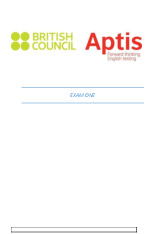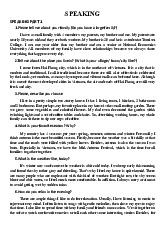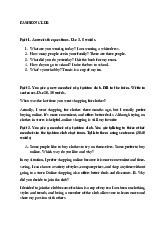



















Preview text:
APTIS TRAINING MATERIAL Aptis Practice Materials Speaking Mock Test Level: A1 – C1 1 APTIS TRAINING MATERIAL
Mock Speaking Test – 12 minutes maximum Outline
The speaking test consists of 4 different parts.
The candidate’s responses are recorded.
A maximum of 5 marks are available for each task.
The test takes about 12 minutes.
Examiner reads everything from here onwards. The candidate speaks after the BEEP.
Part 1: Welcome to the Aptis speaking test. In this part I’m going to ask you three short questions
about yourself and your interest.
You will have 30 seconds to reply to each question. Begin speaking when you hear this sound (BEEP)
• Please tell me about your first school. (BEEP)
• Tell me about the last time you visited an old friend (BEEP)
• Tell me about your favourite singer. (BEEP)
Part 2: In this part I am going to ask you to describe a picture. Then I will ask you two more questions
about it. You’ll have 45 seconds for each response. Begin speaking when your hear this sound (BEEP)
Can you describe this picture in detail for me (BEEP) (45 seconds)
• Tell me about a time when you laughed a lot. (BEEP )
• Do people from different countries laugh at the same things? (BEEP) 2 APTIS TRAINING MATERIAL
Part 3: In this part I am going to ask you to compare two pictures and I will then ask you two
questions about them. You will have 45 seconds for each response. Begin speaking when you hear this sound (BEEP)
Describe what you see in the two pictures (BEEP)
• What sort of people go to each shop and why? (BEEP)
• Which kind of shop do you usually go to and why? (BEEP) 3 APTIS TRAINING MATERIAL
Part 4: In this part, I am going to show you a picture and ask you 3 questions. You will have one
minute to think about your answers before you start speaking. You will have two minutes to answer
all three questions. Begin speaking when you hear this sound (BEEP)
Look at the photograph. (10 seconds to look)
• Tell me about a time when you got lost. • How did you feel?
• What do people usually do when they get lost?
You will have one minute to think about your answers, you may make notes if you wish…
You now have 2 minutes to answer all 3 questions. (BEEP)
That’s the end of the speaking test, thank you. 4 APTIS TRAINING MATERIAL Aptis Practice Materials Reading Mock Test Level: B1 to C1 5 APTIS TRAINING MATERIAL Aptis Reading (25 Questions – 30 minutes) Task 1
Choose one word (A, B or C) for each space and write the letter on the paper. The first one (0)
is done for you as an example with the answer A marked on your answer paper. Dear Sir,
My son, Kevin, left 0) __A__ two months ago and now he is looking for his first 1)______. The
problem is that companies always 2)____ they want people with experience, but how can he
get experience if no one gives him a job? He reads the 3)________ in the paper every day, but
there is nothing for people like him. Today he’s 4)________ some gardening for our
neighbours to 5)________ a bit of money, but he needs a real job. Mr. G Carter EXAMPLE 0 A school B home C m e 1 A work B jo b C occupatio n 2 A say B tel l C as k 3 A new s B tex t C adverts 4 A making B having C doing 5 A earn B ge t C spen d 6 APTIS TRAINING MATERIAL Task 2
Order the sentences (B-G) below to make a story. Write your answers on the answer paper (Questions 6-11).
The first sentence of the story (A) is given for you on the answer paper as an example. A
Harland Sanders was born in the USA in 1890, but his childhood wasn’t a happy one. B
That was when he first learned to cook. C
Over the next nine years Harland developed his secret chicken recipe that made him famous. D
Sanders continued to work for KFC as a public spokesman and visited restaurants all
over the world until he died in 1980, aged 90. E
His father died when he was four and his mother had to find a job to support the
family, so Harland stayed at home to look after his younger brother and sister. F
In the 1950s he decided to close down his restaurant and sold the secret recipe to
other businesses one of which became Kentucky Fried Chicken. G
He left home when he was twelve and he had a number of different jobs, including
being a service station manager in Corbin, Kentucky, where he cooked for hungry travellers. 0) A 6) 7) 8) 9) 10) 11)
(text adapted from http://www.ronford.net/ui/kfc3/townsquare/colonel/colhistory1.htm) 7 APTIS TRAINING MATERIAL Task 3
Read the text and match each space (12-18) with one word from the box below. Write the
letters (A-K) on the Answer Sheet. The answer to question 00 is given on your answer paper as
an example (L). You will not need to find five of the words.
A Hong Kong hotel has sold individual 00 to be used as homes. It's one of the ways 12 are
trying to cope with soaring housing prices, which are among the highest in the world. The
hotel suites are cheaper than apartments in Hong Kong. Hundreds of people 13 up for hours to
buy a unit at the Apex Horizon Hotel this week. It's not clear whether investors can legally live
in the suites but buyers are still eager. The hotel was able to sell all 360 of its suites in two
days - a sign there is a 14 for affordable housing. Hong Kong's low 15 rate has
attracted hordes of mainland Chinese investors. It pushed home prices to record highs last
year. Flats 16 an average of US$14,000 per square metre in central locations. Many residents
feel they can no longer 17 to buy apartments.
Hong Kong people cope by renting makeshif
t homes on rooftops, while others move into so-
called cage homes - hutches made from wire-mesh, stacked on top of each other in a tiny
room. The government's efforts to cool down 18 prices have not worked. So Hong Kong
residents have to be creative in finding space to live. (text adapted from
http://www.bbc.co.uk/worldservice/learningenglish/language/wordsinthenews/2013/02/130225_witn_hotel_home.shtml) Your answers: 00 = L A queued 12 = B interest 13 = C afford 14 = D spend 15 = E residents 16 = F investors 17 = G property 18 = H save I lined J cos t K deman d L rooms 8 APTIS TRAINING MATERIAL Task 4
Read the text below. Match the headings A-H to the paragraphs 0-5 (Questions 19-23). Write
your answers (A-H) on the paper. There 3 headings you don’t need.
The answer to Paragraph 0 is given on the answer paper as an example (J). Your answers: A
Domestic specialties for the whole country 0) I B The current pizza varieties 19) C
The reason why we can’t take it home from the supermarket 20) D
No pizza is complete without cheese 21) E
You can be thankful for the poor 22) F Where it comes from 23) G Tasty for all the family H Tribute to the First Lady I
Nothing compares to the original
0. There are not too many nations that can say their national dish has become an international
phenomenon. Italy has two such dishes, pasta and of course pizza. In America pizza usually
falls into two categories: thick and cheesy Chicago style or thin and traditional New York pizza.
In Italy pizza also falls into two distinct categories: Italian pizza and the rest of the world. It
might seem silly considering the basic ingredients, but one taste of a true Italian pizza and
that's it. You will never feel the same about this simple and delicious food again.
1. In its basic ‘ seasoned flatbread’ form, pizza has a long history in the Mediterranean.
Several cultures including the Greeks ate a flatbread made from flour and water. The dough
would be cooked by placing it on a hot stone and then seasoned with herbs. The Greeks called
this early pizza "plankuntos" and it was basically used as an edible plate when eating stews or
thick broth. It was not yet what we would call pizza today. These early pizzas were eaten from
Rome to Egypt to Babylon and were praised by the ancient historians Herodotus and Cato the Elder. 9 APTIS TRAINING MATERIAL
2. The introduction of tomatoes to Italian cuisine in the 18th and early 19th centuries
finally gave us the true modern Italian pizza. Even though tomatoes reached Italy by the 1530s
it was widely thought that they were poisonous and were grown only for decoration.
However, the innovative (and probably starving) peasants of Naples started using the
supposedly deadly fruit in many of their foods, including their early pizzas. Since that fateful
day when peasants first used tomatoes, the world of Italian cuisine would never be the same,
however, it took some time for the rest of society to accept this crude peasant food. Once
members of the local aristocracy tried pizza they couldn't get enough of it, which by this time
was being sold on the streets of Naples for every meal.
3. As pizza popularity increased, street vendors gave way to actual shops where people
could order a custom pizza with many different toppings. By 1830 the "Antica Pizzeria
Port'Alba" of Naples had become the first true pizzeria and this venerable institution is still
producing masterpieces. The popular pizza Margherita owes its name to Italy's Queen
Margherita who in 1889 visited the Pizzeria Brandi in Naples. The Pizzaioli (pizza maker) on
duty that day, created a pizza for the Queen that contained the three colours of the new
Italian flag. The red of tomato, white of the mozzarella and fresh green basil was a hit with the
Queen and the rest of the world. Neapolitan style pizza had now spread throughout Italy.
4. The Pizza Margherita may have set the standard, but there are numerous popular
varieties of pizza made in Italy today. Pizza from a pizzeria is the recognized round shape,
made to order and always cooked in a wool fired oven. Regional Italian varieties are always
worth trying such as Pizza Marinara, a traditional Neapolitan from the south of Italy is a pizza
that has oregano, anchovies and lots of garlic. Pizza Napoli: tomato mozzarella and anchovies.
Capricciosa: a topping of mushrooms, prosciutto, artichoke hearts, olives and a boiled egg.
Pizza Pugliese makes use of the local capers and olives of the area while Pizza Veronese from
the north of Italy has mushrooms and tender Prosciutto crudo. Pizzas from the Italian island of
Sicily can have numerous toppings ranging from green olives, seafood, hard-boiled eggs and peas.
5. One thing to keep in mind when ordering pizza in an Italian pizzeria is that the product
is personal size. Each person at a table should order their own individual pizza - one bite will
explain why. In certain areas outside Italy, there are a few Piazzioli who keep to their
homeland traditions as best they can with the ingredients they have, but it really isn't the
same. In the end there is no going back once you try a real Italian pizza, no delivery or frozen
product will ever stimulate your taste buds the way a real Italian pizza will!
Adapted from the article of Justin Demetri, lifeinitaly.com, TELC Angol Vizsgafeladatok) 10




